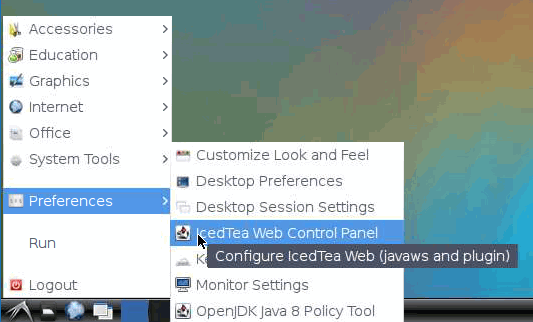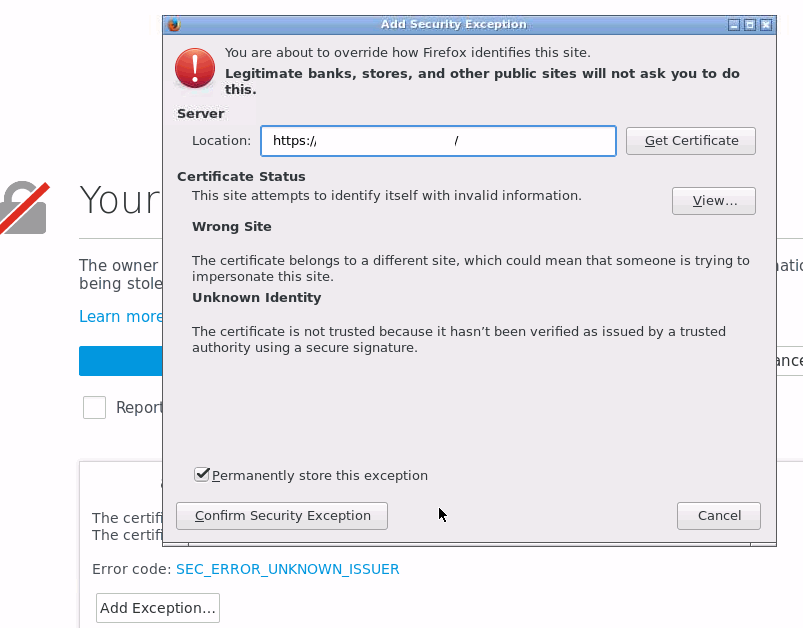# docker-ubuntu-vnc-desktop-centminmod
**Repository Path**: suncf/docker-ubuntu-vnc-desktop-centminmod
## Basic Information
- **Project Name**: docker-ubuntu-vnc-desktop-centminmod
- **Description**: No description available
- **Primary Language**: Unknown
- **License**: Apache-2.0
- **Default Branch**: master
- **Homepage**: None
- **GVP Project**: No
## Statistics
- **Stars**: 0
- **Forks**: 0
- **Created**: 2018-07-17
- **Last Updated**: 2020-12-18
## Categories & Tags
**Categories**: Uncategorized
**Tags**: None
## README
## docker-ubuntu-vnc-desktop
Docker image to provide HTML5 VNC interface to access Ubuntu 16.04 LXDE desktop environment with added [netboot.xyz](https://netboot.xyz/) iso access in directory `/iso/netboot.xyz.iso`.
Quick Start
-------------------------
Run the docker container and access with port `6080`
```
docker run -p 6080:80 centminmod/docker-ubuntu-vnc-desktop
```
Browse http://127.0.0.1:6080/
 VNC Viewer
------------------
Forward VNC service port 5900 to host by
```
docker run -it --rm -p 6080:80 -p 5900:5900 centminmod/docker-ubuntu-vnc-desktop
```
Now, open the vnc viewer and connect to port 5900. If you would like to protect vnc service by password, set environment variable `VNC_PASSWORD`, for example
```
docker run -it --rm -p 6080:80 -p 5900:5900 -e VNC_PASSWORD=mypassword centminmod/docker-ubuntu-vnc-desktop
```
A prompt will ask password either in the browser or vnc viewer.
VNC Viewer
------------------
Forward VNC service port 5900 to host by
```
docker run -it --rm -p 6080:80 -p 5900:5900 centminmod/docker-ubuntu-vnc-desktop
```
Now, open the vnc viewer and connect to port 5900. If you would like to protect vnc service by password, set environment variable `VNC_PASSWORD`, for example
```
docker run -it --rm -p 6080:80 -p 5900:5900 -e VNC_PASSWORD=mypassword centminmod/docker-ubuntu-vnc-desktop
```
A prompt will ask password either in the browser or vnc viewer.
 HTTP Base Authentication
---------------------------
This image provides base access authentication of HTTP via `HTTP_PASSWORD`
```
docker run -p 6080:80 -e HTTP_PASSWORD=mypassword centminmod/docker-ubuntu-vnc-desktop
```
SSL
--------------------
To connect with SSL, generate self signed SSL certificate first if you don't have it
```
mkdir -p ssl
openssl req -x509 -nodes -days 365 -newkey rsa:2048 -keyout ssl/nginx.key -out ssl/nginx.crt
```
Specify SSL port by `SSL_PORT`, certificate path to `/etc/nginx/ssl`, and forward it to 6081
```
docker run -p 6081:443 -e SSL_PORT=443 -v ${PWD}/ssl:/etc/nginx/ssl centminmod/docker-ubuntu-vnc-desktop
```
Screen Resolution
------------------
Resolution of virtual desktop adapts browser window size when first connecting the server. You may choose a fixed resolution by passing `RESOLUTION` environment variable, for example
```
docker run -p 6080:80 -p 5900:5900 -e VNC_PASSWORD=mypassword -e RESOLUTION=1920x1080 centminmod/docker-ubuntu-vnc-desktop
```
Default Desktop User
--------------------
The default user is `root`. You may change the user and password respectively by `USER` and `PASSWORD` environment variable, for example,
```
docker run -p 6080:80 -e USER=doro -e PASSWORD=password centminmod/docker-ubuntu-vnc-desktop
```
Sound (Preview version and Linux only)
-------------------
It only works in Linux.
First of all, insert kernel module `snd-aloop` and specify `2` as the index of sound loop device
```
sudo modprobe snd-aloop index=2
```
Start the container
```
docker run -it --rm -p 6080:80 --device /dev/snd -e ALSADEV=hw:2,0 centminmod/docker-ubuntu-vnc-desktop
```
where `--device /dev/snd -e ALSADEV=hw:2,0` means to grant sound device to container and set basic ASLA config to use card 2.
Launch a browser with URL http://127.0.0.1:6080/#/?video, where `video` means to start with video mode. Now you can start Chromium in start menu (Internet -> Chromium Web Browser Sound) and try to play some video.
Following is the screen capture of these operations. Turn on your sound at the end of video!
[](http://www.youtube.com/watch?v=Kv9FGClP1-k)
## Dell iDRAC 6 IPMI Java Console Usage
Go into IcedTea web panel and lower the `Extended applet security` level for java applets
HTTP Base Authentication
---------------------------
This image provides base access authentication of HTTP via `HTTP_PASSWORD`
```
docker run -p 6080:80 -e HTTP_PASSWORD=mypassword centminmod/docker-ubuntu-vnc-desktop
```
SSL
--------------------
To connect with SSL, generate self signed SSL certificate first if you don't have it
```
mkdir -p ssl
openssl req -x509 -nodes -days 365 -newkey rsa:2048 -keyout ssl/nginx.key -out ssl/nginx.crt
```
Specify SSL port by `SSL_PORT`, certificate path to `/etc/nginx/ssl`, and forward it to 6081
```
docker run -p 6081:443 -e SSL_PORT=443 -v ${PWD}/ssl:/etc/nginx/ssl centminmod/docker-ubuntu-vnc-desktop
```
Screen Resolution
------------------
Resolution of virtual desktop adapts browser window size when first connecting the server. You may choose a fixed resolution by passing `RESOLUTION` environment variable, for example
```
docker run -p 6080:80 -p 5900:5900 -e VNC_PASSWORD=mypassword -e RESOLUTION=1920x1080 centminmod/docker-ubuntu-vnc-desktop
```
Default Desktop User
--------------------
The default user is `root`. You may change the user and password respectively by `USER` and `PASSWORD` environment variable, for example,
```
docker run -p 6080:80 -e USER=doro -e PASSWORD=password centminmod/docker-ubuntu-vnc-desktop
```
Sound (Preview version and Linux only)
-------------------
It only works in Linux.
First of all, insert kernel module `snd-aloop` and specify `2` as the index of sound loop device
```
sudo modprobe snd-aloop index=2
```
Start the container
```
docker run -it --rm -p 6080:80 --device /dev/snd -e ALSADEV=hw:2,0 centminmod/docker-ubuntu-vnc-desktop
```
where `--device /dev/snd -e ALSADEV=hw:2,0` means to grant sound device to container and set basic ASLA config to use card 2.
Launch a browser with URL http://127.0.0.1:6080/#/?video, where `video` means to start with video mode. Now you can start Chromium in start menu (Internet -> Chromium Web Browser Sound) and try to play some video.
Following is the screen capture of these operations. Turn on your sound at the end of video!
[](http://www.youtube.com/watch?v=Kv9FGClP1-k)
## Dell iDRAC 6 IPMI Java Console Usage
Go into IcedTea web panel and lower the `Extended applet security` level for java applets

 Launch Firefox browser and go to your IPMI web login and add a permenant exception for HTTPS based IPMI login
Launch Firefox browser and go to your IPMI web login and add a permenant exception for HTTPS based IPMI login

 Launch console and open with `IceTea Java Web Start` + check trust publisher and content.
Launch console and open with `IceTea Java Web Start` + check trust publisher and content.


 Answer yes to run java console applet
Answer yes to run java console applet


 Troubleshooting
1. boot2docker connection issue, https://github.com/fcwu/docker-ubuntu-vnc-desktop/issues/2
## License
See the LICENSE file for details.
Troubleshooting
1. boot2docker connection issue, https://github.com/fcwu/docker-ubuntu-vnc-desktop/issues/2
## License
See the LICENSE file for details. VNC Viewer
------------------
Forward VNC service port 5900 to host by
```
docker run -it --rm -p 6080:80 -p 5900:5900 centminmod/docker-ubuntu-vnc-desktop
```
Now, open the vnc viewer and connect to port 5900. If you would like to protect vnc service by password, set environment variable `VNC_PASSWORD`, for example
```
docker run -it --rm -p 6080:80 -p 5900:5900 -e VNC_PASSWORD=mypassword centminmod/docker-ubuntu-vnc-desktop
```
A prompt will ask password either in the browser or vnc viewer.
VNC Viewer
------------------
Forward VNC service port 5900 to host by
```
docker run -it --rm -p 6080:80 -p 5900:5900 centminmod/docker-ubuntu-vnc-desktop
```
Now, open the vnc viewer and connect to port 5900. If you would like to protect vnc service by password, set environment variable `VNC_PASSWORD`, for example
```
docker run -it --rm -p 6080:80 -p 5900:5900 -e VNC_PASSWORD=mypassword centminmod/docker-ubuntu-vnc-desktop
```
A prompt will ask password either in the browser or vnc viewer.
 HTTP Base Authentication
---------------------------
This image provides base access authentication of HTTP via `HTTP_PASSWORD`
```
docker run -p 6080:80 -e HTTP_PASSWORD=mypassword centminmod/docker-ubuntu-vnc-desktop
```
SSL
--------------------
To connect with SSL, generate self signed SSL certificate first if you don't have it
```
mkdir -p ssl
openssl req -x509 -nodes -days 365 -newkey rsa:2048 -keyout ssl/nginx.key -out ssl/nginx.crt
```
Specify SSL port by `SSL_PORT`, certificate path to `/etc/nginx/ssl`, and forward it to 6081
```
docker run -p 6081:443 -e SSL_PORT=443 -v ${PWD}/ssl:/etc/nginx/ssl centminmod/docker-ubuntu-vnc-desktop
```
Screen Resolution
------------------
Resolution of virtual desktop adapts browser window size when first connecting the server. You may choose a fixed resolution by passing `RESOLUTION` environment variable, for example
```
docker run -p 6080:80 -p 5900:5900 -e VNC_PASSWORD=mypassword -e RESOLUTION=1920x1080 centminmod/docker-ubuntu-vnc-desktop
```
Default Desktop User
--------------------
The default user is `root`. You may change the user and password respectively by `USER` and `PASSWORD` environment variable, for example,
```
docker run -p 6080:80 -e USER=doro -e PASSWORD=password centminmod/docker-ubuntu-vnc-desktop
```
Sound (Preview version and Linux only)
-------------------
It only works in Linux.
First of all, insert kernel module `snd-aloop` and specify `2` as the index of sound loop device
```
sudo modprobe snd-aloop index=2
```
Start the container
```
docker run -it --rm -p 6080:80 --device /dev/snd -e ALSADEV=hw:2,0 centminmod/docker-ubuntu-vnc-desktop
```
where `--device /dev/snd -e ALSADEV=hw:2,0` means to grant sound device to container and set basic ASLA config to use card 2.
Launch a browser with URL http://127.0.0.1:6080/#/?video, where `video` means to start with video mode. Now you can start Chromium in start menu (Internet -> Chromium Web Browser Sound) and try to play some video.
Following is the screen capture of these operations. Turn on your sound at the end of video!
[](http://www.youtube.com/watch?v=Kv9FGClP1-k)
## Dell iDRAC 6 IPMI Java Console Usage
Go into IcedTea web panel and lower the `Extended applet security` level for java applets
HTTP Base Authentication
---------------------------
This image provides base access authentication of HTTP via `HTTP_PASSWORD`
```
docker run -p 6080:80 -e HTTP_PASSWORD=mypassword centminmod/docker-ubuntu-vnc-desktop
```
SSL
--------------------
To connect with SSL, generate self signed SSL certificate first if you don't have it
```
mkdir -p ssl
openssl req -x509 -nodes -days 365 -newkey rsa:2048 -keyout ssl/nginx.key -out ssl/nginx.crt
```
Specify SSL port by `SSL_PORT`, certificate path to `/etc/nginx/ssl`, and forward it to 6081
```
docker run -p 6081:443 -e SSL_PORT=443 -v ${PWD}/ssl:/etc/nginx/ssl centminmod/docker-ubuntu-vnc-desktop
```
Screen Resolution
------------------
Resolution of virtual desktop adapts browser window size when first connecting the server. You may choose a fixed resolution by passing `RESOLUTION` environment variable, for example
```
docker run -p 6080:80 -p 5900:5900 -e VNC_PASSWORD=mypassword -e RESOLUTION=1920x1080 centminmod/docker-ubuntu-vnc-desktop
```
Default Desktop User
--------------------
The default user is `root`. You may change the user and password respectively by `USER` and `PASSWORD` environment variable, for example,
```
docker run -p 6080:80 -e USER=doro -e PASSWORD=password centminmod/docker-ubuntu-vnc-desktop
```
Sound (Preview version and Linux only)
-------------------
It only works in Linux.
First of all, insert kernel module `snd-aloop` and specify `2` as the index of sound loop device
```
sudo modprobe snd-aloop index=2
```
Start the container
```
docker run -it --rm -p 6080:80 --device /dev/snd -e ALSADEV=hw:2,0 centminmod/docker-ubuntu-vnc-desktop
```
where `--device /dev/snd -e ALSADEV=hw:2,0` means to grant sound device to container and set basic ASLA config to use card 2.
Launch a browser with URL http://127.0.0.1:6080/#/?video, where `video` means to start with video mode. Now you can start Chromium in start menu (Internet -> Chromium Web Browser Sound) and try to play some video.
Following is the screen capture of these operations. Turn on your sound at the end of video!
[](http://www.youtube.com/watch?v=Kv9FGClP1-k)
## Dell iDRAC 6 IPMI Java Console Usage
Go into IcedTea web panel and lower the `Extended applet security` level for java applets

 Launch Firefox browser and go to your IPMI web login and add a permenant exception for HTTPS based IPMI login
Launch Firefox browser and go to your IPMI web login and add a permenant exception for HTTPS based IPMI login

 Launch console and open with `IceTea Java Web Start` + check trust publisher and content.
Launch console and open with `IceTea Java Web Start` + check trust publisher and content.


 Answer yes to run java console applet
Answer yes to run java console applet


 Troubleshooting
1. boot2docker connection issue, https://github.com/fcwu/docker-ubuntu-vnc-desktop/issues/2
## License
See the LICENSE file for details.
Troubleshooting
1. boot2docker connection issue, https://github.com/fcwu/docker-ubuntu-vnc-desktop/issues/2
## License
See the LICENSE file for details.